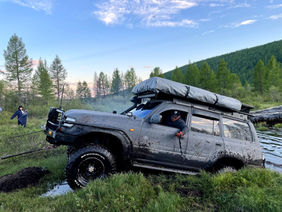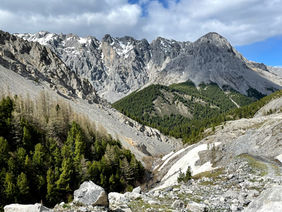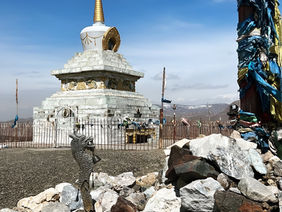
TERRA FIRMA JOURNEYS

MONGOLIA

Yearn for an adventure that rips the ordinary from your travel journal? Ditch the crowds and tourist trails for the untamed soul of Mongolia. Ride bareback across Mongolia's wild steppes. Imagine the wind whipping through your hair as you gallop beneath a sky ablaze with stars. Or picture yourself conquering a windswept dune, gazing across a vibrant tapestry of wildflowers. This isn't your average vacation - it's an unforgettable adventure into the soul of Mongolia.
OUR MONGOLIA TOURS


MONGOLIA OVERVIEW
Cradled between Russia and China, Mongolia stretches out like a giant, landlocked canvas (nearly twice the size of Texas) painted with diverse landscapes. The mighty Altai Mountains stand guard in the west, their snow-capped peaks a stark contrast to the vast Gobi Desert sprawling in the south. These dramatic landscapes whisper tales of Mongolia's nomadic past. The central plateau, a seemingly endless ocean of steppe grasslands, pulsates with life.
Grazing herds and nomadic herders, their culture intricately woven with the land, paint a moving picture on this vast canvas. Further north, the scene shifts to dense taiga forests, offering a cool refuge for reindeer and other creatures adapted to the cold. Ulaanbaatar, the vibrant capital city, stands at the crossroads of tradition and modernity. Here, ancient Buddhist monasteries, silent sentinels of a rich past, share the skyline with modern skyscrapers, symbols of a young democracy. In this unique blend of old and new, echoes of the Mongol Empire, a reminder of a glorious past, mingle with the energy of a nation on the rise, creating a truly unforgettable cultural experience.
Mongolia's landscapes captivate. Central Khangai Mountains challenge adventurers with jagged peaks and glacial valleys, while the south unfolds as a vast steppe. These grasslands transform from vibrant green to gold in autumn, then a snowy wonderland in winter. Nomadic herders have called these plains home for centuries.
While the Gobi Desert captures the imagination, Mongolia boasts a wealth of freshwater treasures. Crystal-clear lakes like Khuvsgul, nicknamed Siberia's little sister, shimmer in the northern reaches. This "Great Lakes Depression" contains over 300 freshwater bodies, some nestled amidst the forested hills, others reflecting the vastness of the steppe. Lush meadows overflowing with wildflowers in spring and summer provide sustenance for grazing animals and a kaleidoscope of color for visitors. Volcanic activity has also sculpted Mongolia's landscape. In the eastern reaches, the extinct volcanoes of the Dariganga Plateau rise from the plains, their otherworldly forms a testament to the earth's fiery past. Deep canyons carved by ancient rivers snake through this volcanic terrain, offering a glimpse into Mongolia's geological history.
Beyond these iconic landscapes, Mongolia holds hidden gems. The dramatic cliffs of the Yolyn Am gorge, adorned with ancient petroglyphs, stand sentinel in the west. During winter, the gorge transforms into a breathtaking ice palace, with waterfalls frozen in time. The Khogno Khan National Park, a UNESCO World Heritage Site, protects a diverse ecosystem of mountains, steppes, and taiga forests. Here, rare wildlife like the majestic Argali sheep and the elusive snow leopard roam free, a testament to the park's pristine wilderness. Mongolia's natural beauty extends beyond its landforms. The vast, star-studded night sky, virtually untouched by light pollution, offers a breathtaking spectacle, a reminder of the universe's vastness.


Mongolia offers a unique adventure for every traveler. History buffs can explore the legacy of Genghis Khan and his vast empire, visiting ancient ruins and burial mounds. Nature lovers can trek across the endless steppes, hike snow-capped mountains, or even camp beside a pristine lake under a star-studded sky. For those seeking cultural immersion, Mongolia offers the chance to experience the nomadic lifestyle, learning about herding traditions and even staying in a traditional ger (felt tent). Adventure seekers can test their skills on horseback riding expeditions, challenging themselves on rugged terrain.
Life in Mongolia revolves around nature, community, and resilience. Nomadic families move with the seasons, herding their animals across the vast grasslands. Traditional festivals celebrate cultural heritage and horsemanship. Even in the growing cities, strong community bonds remain, with families and friends gathering for meals and celebrations. Mongolia's harsh climate fosters a resourceful spirit, with locals making the most of their surroundings and cherishing moments of shared warmth and hospitality.
Travel Info About Mongolia
Visa Process
The visa process for Mongolia will depend on your nationality and the length of your stay. Generally, citizens from many countries can apply for an e-visa online, which is a quick and convenient way to obtain a visa. You can find out if you are eligible for an e-visa and apply on the Mongolian e-visa website [evisa.mn].
Currency
The currency used in Mongolia is the Mongolian tögrög (MNT). While credit cards are becoming more widely accepted in major cities and tourist areas, we advice you to carry cash always. You can exchange your currency for Mongolian tögrög at currency exchange offices.
Official Language of Mongolia
The official language of Mongolia is Mongolian. However, many people in the tourism industry also speak English or Russian. Learning a few basic Mongolian phrases can go a long way in enhancing your travel experience and connecting with the locals.
Public Transportation
-
Buses: The primary mode of transportation between cities and provinces is the regional bus network. Buses offer a budget-friendly option compared to flights, with some routes operating overnight for longer distances. Advance reservations are recommended, especially during peak travel seasons.
-
Minibuses: Shared minibuses, often referred to as "marshrutkas," are another option for shorter distances, particularly within Ulaanbaatar. Fares are typically inexpensive, but these can be crowded and less comfortable than buses.
-
Taxis: Taxis are readily available in Ulaanbaatar and larger towns, but negotiate fares beforehand to avoid misunderstandings.
-
Domestic Flights: While less common for budget travelers, domestic flights connect major cities like Ulaanbaatar to remote areas like Hovd or Mörön.
Notes
Mongolia observes Standard Time (GMT+08:00) year-round. Factor in any time difference when planning your trip.
Bargaining is customary at local markets and with some street vendors.
Tipping is not widely expected but appreciated in tourist establishments.
Be prepared for extreme weather conditions, as Mongolia experiences both scorching summers and frigid winters. Pack accordingly for your travel season.




















